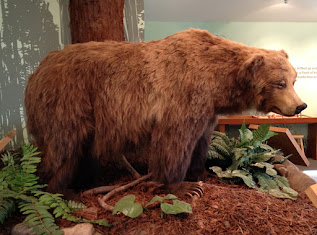"Waddell’s Mill – W. W. Waddell & Co. of Santa Cruz have been engaged, for more than two years last past in the extensive preparations for manufacturing lumber. Their situation is below New Year’s Point (punta den ano nueve) on the Casa del Ursa, more familiarly known as Waddell’s creek."
 |
| Grizzly at the Rancho del Oso Nature & History Center. |
The bear weighed nearly 1000 pounds when it was shot and skinned. The kill was documented in the book Hunting with the Bow and Arrow by Saxton Pope:
"Next day, just at sunset, we got our first view of the great bear of Dunraven Pass. He was coming down a distant canyon trail. He looked like a giant in the twilight. With long swinging strides he threw himself impetuously down the mountainside. Great power was in every movement. He was magnificent!"
"... the monster grizzly was romping back and forth in the shaded forest not more than sixty-five yards away. With deep booming growls like distant thunder, he voiced his anger and intent to kill. As he flitted between the shadows of the trees, the moonlight glinted on his massive body; he was enormous.
Young discharged three arrows at him. I shot two. We should have landed, he was so large. But he galloped off and I saw my last arrow at the point blank range of seventy-five yards, fall between his legs. He was gone. We thought we had missed the beast and grief descended heavy upon us. The thought of all the weary days and nights of hunting and waiting, and now to have lost him, was very painful."
"... We had no idea that we hit the great bear, but just to gather up our shafts, we went over the ground where he had been.
One of Young's arrows was missing! That gave us a thrill; perhaps we had hit him after all! We went further in the direction he had gone; there was a trace of blood.
We trailed him."
"... We let ourselves down the sheer descent, came upon a narrow little ledge, and there below us lay the huge monster on his back, against a boulder, cold and stiff, as dead as Caesar. Our hearts nearly burst with happiness.
There lay the largest grizzly bear in Wyoming, dead at our feet. His rugged coat was matted with blood. Well back in his chest the arrow wound showed clear. I measured him; twenty-six inches of bear had been pierced through and through. One arrow killed him. He was tremendous. His great wide head; his worn, glistening teeth; his massive arms; his vast, ponderous feet and long curved claws; all were there. He was a wonderful beast. It seemed incredible. I thumped Young on the shoulder: 'My, that was a marvelous shot!'"
"Next day, just at sunset, we got our first view of the great bear of Dunraven Pass. He was coming down a distant canyon trail. He looked like a giant in the twilight. With long swinging strides he threw himself impetuously down the mountainside. Great power was in every movement. He was magnificent!"
"... the monster grizzly was romping back and forth in the shaded forest not more than sixty-five yards away. With deep booming growls like distant thunder, he voiced his anger and intent to kill. As he flitted between the shadows of the trees, the moonlight glinted on his massive body; he was enormous.
Young discharged three arrows at him. I shot two. We should have landed, he was so large. But he galloped off and I saw my last arrow at the point blank range of seventy-five yards, fall between his legs. He was gone. We thought we had missed the beast and grief descended heavy upon us. The thought of all the weary days and nights of hunting and waiting, and now to have lost him, was very painful."
 |
| San Francisco Chronicle, July 4, 1920. |
One of Young's arrows was missing! That gave us a thrill; perhaps we had hit him after all! We went further in the direction he had gone; there was a trace of blood.
We trailed him."
"... We let ourselves down the sheer descent, came upon a narrow little ledge, and there below us lay the huge monster on his back, against a boulder, cold and stiff, as dead as Caesar. Our hearts nearly burst with happiness.
 |
| From Hunting with Bow and Arrow by Saxton Pope, 1923. |
In their souvenir booklet about the North American Hall, the California Academy of Sciences wrote:
"It is deeply regretted that this Museum cannot show a habitat group of grizzlies from California, but the next best thing has been done; a group of a closely related form, the Imperial Grizzly (Ursus horribilis imperator), still existing in north-western Wyoming, is here presented.
The individuals arranged in this group were taken with bow and arrow in the Yellowstone Park region in July, 1920, by the late Dr. Saxon Pope and Mr. Arthur Young, both of San Francisco."
"It is deeply regretted that this Museum cannot show a habitat group of grizzlies from California, but the next best thing has been done; a group of a closely related form, the Imperial Grizzly (Ursus horribilis imperator), still existing in north-western Wyoming, is here presented.
 |
California Academy of Sciences Postcard. Photograph by Ansel Adams. |
The individuals arranged in this group were taken with bow and arrow in the Yellowstone Park region in July, 1920, by the late Dr. Saxon Pope and Mr. Arthur Young, both of San Francisco."

No comments:
Post a Comment